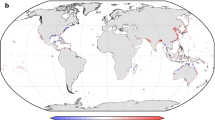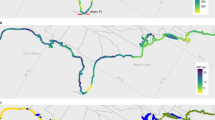Abstract
We define ‘grey swan’ tropical cyclones as high-impact storms that would not be predicted based on history but may be foreseeable using physical knowledge together with historical data. Here we apply a climatological–hydrodynamic method to estimate grey swan tropical cyclone storm surge threat for three highly vulnerable coastal regions. We identify a potentially large risk in the Persian Gulf, where tropical cyclones have never been recorded, and larger-than-expected threats in Cairns, Australia, and Tampa, Florida. Grey swan tropical cyclones striking Tampa, Cairns and Dubai can generate storm surges of about 6 m, 5.7 m and 4 m, respectively, with estimated annual exceedance probabilities of about 1/10,000. With climate change, these probabilities can increase significantly over the twenty-first century (to 1/3,100–1/1,100 in the middle and 1/2,500–1/700 towards the end of the century for Tampa). Worse grey swan tropical cyclones, inducing surges exceeding 11 m in Tampa and 7 m in Dubai, are also revealed with non-negligible probabilities, especially towards the end of the century.
This is a preview of subscription content, access via your institution
Access options
Subscribe to this journal
Receive 12 print issues and online access
$209.00 per year
only $17.42 per issue
Buy this article
- Purchase on Springer Link
- Instant access to full article PDF
Prices may be subject to local taxes which are calculated during checkout





Similar content being viewed by others
References
Taleb, N. N. The Black Swan: The Impact of the Highly Improbable Fragility (Random House LLC, 2010).
Aven, T. On the meaning of a black swan in a risk context. Saf. Sci. 57, 44–51 (2013).
Nafday, A. M. Strategies for managing the consequences of black swan events. Leadership Manage. Eng. 9, 191–197 (2009).
Stein, J. L. & Stein, S. Gray swans: Comparison of natural and financial hazard assessment and mitigation. Nat. Hazards 72, 1279–1297 (2014).
Paté Cornell, E. On “Black Swans” and “Perfect Storms”: Risk analysis and management when statistics are not enough. Risk Anal. 32, 1823–1833 (2012).
Needham, H., Keim, B. D. & Sathiaraj, D. A review of tropical cyclone-generated storm surges: Global data sources, observations and impacts. Rev. Geophys. 53, 545–591 (2015).
Fritz, H. M. et al. Hurricane Katrina storm surge distribution and field observations on the Mississippi Barrier Islands. Estuar. Coast. Shelf Sci. 74, 12–20 (2007).
Travis, J. Scientists’ fears come true as hurricane floods New Orleans. Science 309, 1656–1659 (2005).
Fritz, H. M., Blount, C. D., Thwin, S., Thu, M. K. & Chan, N. Cyclone Nargis storm surge in Myanmar. Nature Geosci. 2, 448–449 (2009).
Scileppi, E. & Donnelly, J. P. Sedimentary evidence of hurricane strikes in western Long Island, New York. Geochem. Geophys. Geosyst. 8, Q06011 (2007).
Brandon, C. M., Woodruff, J. D., Donnelly, J. P. & Sullivan, R. M. How unique was Hurricane Sandy? Sedimentary reconstructions of extreme flooding from New York harbor. Sci. Rep. 4, 7366 (2014).
Lin, N., Emanuel, K. A., Smith, J. A. & Vanmarcke, E. Risk assessment of hurricane storm surge for New York City. J. Geophys. Res. 115, D18121 (2010).
Lin, N., Emanuel, K., Oppenheimer, M. & Vanmarcke, E. Physically based assessment of hurricane surge threat under climate change. Nature Clim. Change 2, 1–6 (2012).
Mas, E. et al. Field survey report and satellite image interpretation of the 2013 Super Typhoon Haiyan in the Philippines. Nat. Hazards Earth Syst. Sci. 15, 817–825 (2015).
Bankoff, G. Cultures of Disaster: Society and Natural Hazard in the Philippines 232 (Routledge Curzon, 2003).
Vickery, P., Skerlj, P. & Twisdale, L. Simulation of hurricane risk in the U.S. using empirical track model. J. Struct. Eng. 126, 1222–1237 (2000).
Toro, G. R., Resio, D. T., Divoky, D., Niedoroda, A. W. & Reed, C. Efficient joint-probability methods for hurricane surge frequency analysis. Ocean Eng. 37, 125–134 (2010).
Hall, T. M. & Sobel, A. H. On the impact angle of Hurricane Sandy’s New Jersey landfall. Geophys. Res. Lett. 40, 2312–2315 (2013).
Emanuel, K., Ravela, S., Vivant, E. & Risi, C. A Statistical deterministic approach to hurricane risk assessment. Bull. Am. Meteorol. Soc. 87, 299–314 (2006).
Emanuel, K., Sundararajan, R. & Williams, J. Hurricanes and global warming: Results from downscaling IPCC AR4 simulations. Bull. Am. Meteorol. Soc. 89, 347–367 (2008).
Emanuel, K. The dependence of hurricane intensity on climate. Nature 326, 483–485 (1987).
Elsner, J. B., Kossin, J. P. & Jagger, T. H. The increasing intensity of the strongest tropical cyclones. Nature 455, 92–95 (2008).
Knutson, T. R. et al. Tropical cyclones and climate change. Nature Geosci. 3, 157–163 (2010).
Emanuel, K. A. Downscaling CMIP5 climate models shows increased tropical cyclone activity over the 21st century. Proc. Natl Acad. Sci. USA 110, 12219–12224 (2013).
Westerink, J. J. et al. A basin- to channel-scale unstructured grid hurricane storm surge model applied to southern Louisiana. Mon. Weath. Rev. 136, 833–864 (2008).
Lin, N., Lane, P., Emanuel, K. A., Sullivan, R. M. & Donnelly, J. P. Heightened hurricane surge risk in northwest Florida revealed from climatological–hydrodynamic modeling and paleorecord reconstruction. J. Geophys. Res. Atmos. 119, 8606–8623 (2014).
Aerts, J. C. J. H., Lin, N., Botzen, W., Emanuel, K. & de Moel, H. Low-probability flood risk modeling for New York City. Risk Anal. 33, 772–788 (2013).
Aerts, J. C. J. H. et al. Evaluating Flood resilience strategies for coastal megacities. Science 344, 473–475 (2014).
Weisberg, R. H. & Zheng, L. Hurricane storm surge simulations for Tampa Bay. Estuar. Coast. 29, 899–913 (2008).
Kalnay, E. et al. The NCEP/NCAR 40-year reanalysis project. Bull. Am. Meteorol. Soc. 77, 437–471 (1996).
Bossak, B. H. Early 19th Century US Hurricanes: A GIS Tool and Climate Analysis PhD dissertation, Florida State Univ. (2003)
Morey, S. L., Baig, S., Bourassa, M. A., Dukhovskoy, D. S. & O’Brien, J. J. Remote forcing contribution to storm-induced sea level rise during Hurricane Dennis. Geophys. Res. Lett. 33, L19603 (2006).
Chavas, D. R. & Emanuel, K. A. A QuikSCAT climatology of tropical cyclone size. Geophys. Res. Lett. 37, 18 (2010).
Rotunno, R. & Emanuel, K. A. 1987: An air-sea interaction theory for tropical cyclones, Part II: Evolutionary study using axisymmetric nonhydrostatic numerical model. J. Atmos. Sci. 44, 542–561
Chavas, D. R. & Emanuel, K. Equilibrium tropical cyclone size in an idealized state of axisymmetric radiative–convective equilibrium∗. J. Atmos. Sci. 71, 1663–1680 (2014).
Emanuel, K. A. An air-sea interaction theory for tropical cyclones. Part I: Steady-state maintenance. J. Atmos. Sci. 43, 585–605 (1986).
Nott, J., Green, C., Townsend, I. & Callaghan, J. The world record storm surge and the most intense southern hemisphere tropical cyclone: New evidence and modeling. Bull. Am. Meteorol. Soc. 95, 757–765 (2014).
Hardy, T., Mason, L. & Astorquia, A. Surge Plus Tide Statistics for Selected Open Coast Locations Along the Queensland East Coast. Queensland Climate Change and Community Vulnerability to Tropical Cyclones. Ocean Hazards Assessment Stage 3 (Queensland Government Report, 2004)
Haigh, I. D. et al. Estimating present day extreme water level exceedance probabilities around the coastline of Australia: Tropical cyclone-induced storm surges. Clim. Dynam. 42, 139–157 (2014).
Nott, J. F. & Jagger, T. H. Deriving robust return periods for tropical cyclone inundations from sediments. Geophys. Res. Lett. 40, 370–373 (2012).
Evan, A. T. & Camargo, S. J. A climatology of Arabian Sea cyclonic storms. J. Clim. 24, 140–158 (2011).
Rienecker, M. M. et al. MERRA: NASA’s modern-era retrospective analysis for research and applications. J. Clim. 24, 3624–3648 (2011).
Shirvani, A., Nazemosadat, S. M. J. & Kahya, E. Analyses of the Persian Gulf sea surface temperature: Prediction and detection of climate change signals. Arab. J. Geosci. 8, 2121–2130 (2015).
Bister, M. & Emanuel, K. A. Low frequency variability of tropical cyclone potential intensity 1. Interannual to interdecadal variability. J. Geophys. Res. 107(D24), 4801 (2002).
Evan, A. T., Kossin, J. P., Eddy’ Chung, C. & Ramanathan, V. Arabian Sea tropical cyclones intensified by emissions of black carbon and other aerosols. Nature 479, 94–97 (2011).
Woodruff, J. D., Irish, J. L. & Camargo, S. J. Coastal flooding by tropical cyclones and sea-level rise. Nature 504, 44–52 (2013).
Emanuel, K., Des Autels, C., Holloway, C. & Korty, R. Environmental control of tropical cyclone intensity. J. Atmos. Sci. 61, 843–858 (2004).
Emanuel, K. & Rotunno, R. Self-stratification of tropical cyclone outflow. Part I: Implications for storm structure. J. Atmos. Sci. 68, 2236–2249 (2011).
Lin, N. & Chavas, D. On hurricane parametric wind and applications in storm surge modeling. J. Geophys. Res. 117, D09120 (2012).
Holland, G. J. An analytic model of the wind and pressure profiles in hurricanes. Mon. Weath. Rev. 108, 1212–1218 (1980).
Luettich, R. A., Westerink, J. J. & Scheffner, N. W. ADCIRC: An Advanced Three-dimensional Circulation Model for Shelves, Coasts and Estuaries, Report 1: Theory and Methodology of ADCIRC-2DDI and ADCIRC-3DL DRP Technical Report DRP-92-6 (Department of the Army, US Army Corps of Engineers, Waterways Experiment Station, 1992)
Dietrich, J. C. et al. Modeling hurricane waves and storm surge using integrally-coupled, scalable computations. Coast. Eng. 58, 45–65 (2011).
Landsea, C. W. et al. A reanalysis of the 1921–1930 Atlantic hurricane database. J. Clim. 25, 865–885 (2012).
Knapp, K. R., Kruk, M. C., Levinson, D. H., Diamond, H. J. & Neumann, C. J. The International Best Track Archive for Climate Stewardship (IBTrACS) unifying tropical cyclonedata. Bull. Am. Meteorol. Soc. 91, 363–376 (2010).
Coles, S. An Introduction to Statistical Modeling of Extreme Values (Springer, 2001).
Acknowledgements
We acknowledge the World Climate Research Program’s Working Group on Coupled Modeling, which is responsible for CMIP, and we thank the climate modelling groups for producing and making available their model output. We thank J. Westerink of the University of Notre Dame and C. Dietrich of North Carolina State University for their technical support on the ADCIRC model applied in this study for storm surge analysis. We also thank G. Holland of National Center for Atmospheric Science and J. Nott of James Cook University for their helpful comments. N.L. acknowledges support from Princeton University’s School of Engineering and Applied Science (Project X Fund) and Andlinger Center for Energy and the Environment (Innovation Fund). K.E. was supported by NSF Grant 1418508.
Author information
Authors and Affiliations
Contributions
K.E. performed numerical modelling of the storms. N.L. carried out storm surge simulations and statistical analysis. N.L. and K.E. co-wrote the paper.
Corresponding author
Ethics declarations
Competing interests
The authors declare no competing financial interests.
Supplementary information
Rights and permissions
About this article
Cite this article
Lin, N., Emanuel, K. Grey swan tropical cyclones. Nature Clim Change 6, 106–111 (2016). https://doi.org/10.1038/nclimate2777
Received:
Accepted:
Published:
Issue Date:
DOI: https://doi.org/10.1038/nclimate2777
This article is cited by
-
The Spatiotemporal Patterns of Community Vulnerability in the U.S. Mobile Bay from 2000–2020
Applied Spatial Analysis and Policy (2024)
-
Increasing sequential tropical cyclone hazards along the US East and Gulf coasts
Nature Climate Change (2023)
-
Erosion and accretion patterns on intertidal mudflats of the Yangtze River Estuary in response to storm conditions
Anthropocene Coasts (2023)
-
Fatigue vulnerability of sea cage to storm wave loads
Journal of Marine Science and Technology (2023)
-
A long-term view of tropical cyclone risk in Australia
Natural Hazards (2023)



